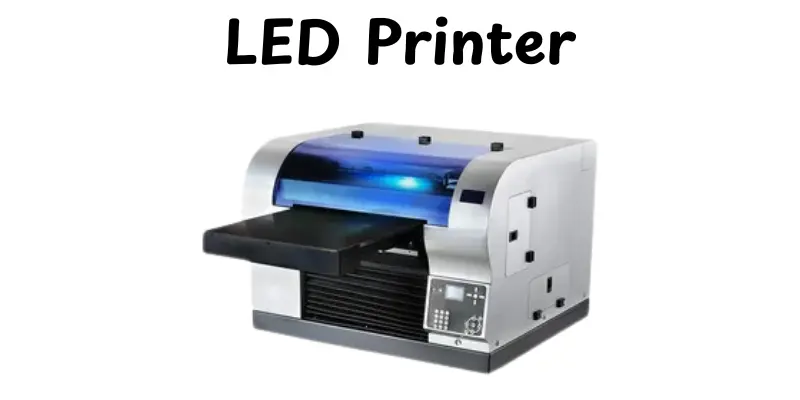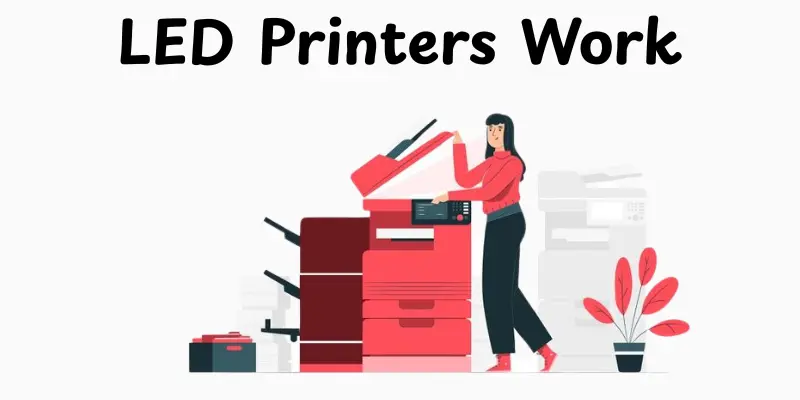What Is LED Printer? Complete Guide For Beginners
Published: 17 Oct 2025
Ever wondered what makes an LED printer from other types of printers, and why many people believe it is faster and less noisy? You’re not alone and it can be difficult at first. Don’t worry, this guide will explain everything. We’ll look at how it works, its advantages and disadvantages, and what makes it a good choice for home and office use. By the end, you’ll know if an LED printer is a good fit for you.
What Is an LED Printer?
An LED printer is a type of digital printer that uses light-emitting diodes (LEDs) to produce pictures on a drum before printing them on paper. It uses small LED lights to produce the print pattern instead of a laser beam, like a laser printer does. These lights turn on and off to produce a picture or word with high accuracy. The drum then draws toner powder to the charged areas, pressing it onto the paper. This method makes LED printers fast, quiet, and reliable. They are commonly used in companies and schools to produce colorful, professional-quality prints.

History of LED Printer
The LED printer’s history dates originally to the late 1980s, when it was introduced as a new type of digital printer. OKI Electric Industry, a Japanese printing business recognized for its creativity, invented the technique. Their goal was to create a printer that works similarly to a laser printer but is simpler and more reliable. By replacing the laser beam with small LED lights, scientists decreased the quantity of moving parts, making the printer to run faster and more effectively. Other companies adopted this technology, and LED printers became known for their speed, accuracy, and durability, especially in schools and offices.
How LED Printers Work

Understanding how an LED printer works is easier than you may think. It uses a simple, step-by-step process to convert digital photographs into quality prints. Here’s a quick explanation of how it works:
- Step 1: Data is sent to the printer.
When you press print, your computer sends the image or document to the printer in digital form. - Step 2: The LED lights create an image.
The printer uses a row of tiny LED lights to shine on a photosensitive drum. These lights turn on and off to form the pattern of your text or image. - Step 3: The drum attracts toner powder.
The areas lit by the LEDs attract toner particles, which stick to the charged spots on the drum. - Step 4: The image transfers to the paper.
The drum rolls over the paper, and the toner is pressed onto it to form the printed image. - Step 5: The toner is fused.
Heat and pressure seal the toner onto the paper, making the print permanent. - Step 6: The paper is released.
The final print comes out dry, clear, and ready to use — all within seconds.
Types of LED Printers
LED printers come in different types based on their color and functionality. Understanding these types permits you to select the best one for your home or workplace needs.
- Monochrome LED Printer:Prints only in black and white, best for text documents and reports.
- Color LED Printer:Produces colorful prints using toner cartridges for each color — ideal for photos, charts, and marketing materials.
- Single-Function LED Printer:Focuses only on printing tasks without scanning or copying features.
- Multifunction LED Printer:Perfect for office use, it combines printing, scanning, copying, and, on certain days, faxing.
- Compact LED Printer:Small and lightweight, designed for home users or small spaces with light printing needs.
Key Parts of an LED Printer
An LED printer has several important parts that work together to create clear and fast prints. Each part has a special work, from sending the image signal to placing toner on paper. Here are the main parts explained simply:
- LED Array:A row of tiny lights that form the image on the drum.
- Drum Unit: Transfers the image from the LED light onto the paper using toner.
- Toner Cartridge:Holds the colored or black powder used to make prints.
- Fuser Unit:Heats and presses the toner onto the paper to make the print permanent.
- Paper Tray:Stores the sheets of paper ready for printing.
- Control Panel:Lets you manage settings like print quality or number of copies.
- Power Supply:Provides energy to run the printer and all its components.
Applications of LED Printer
LED printers have become popular for their speed, reliability, and ease of maintenance. They are ideal for both home and industrial printing needs. Let us have a look at how they are commonly used.
- Offices: Used for printing reports, invoices, and other documents quickly.
- Schools: Helpful for printing assignments, notices, and study materials.
- Home Use: Great for personal documents, projects, and daily printing tasks.
- Graphic Design Studios: Ideal for printing clear designs, charts, and layouts.
- Retail Stores: Used to print receipts, labels, and promotional materials.
- Government Departments: Commonly used for forms, letters, and official records.
- Healthcare Centers: Used for printing patient reports and prescriptions.
LED vs Laser Printers — Which Is Better?
Many people get confused between LED printers and laser printers because they look and work quite similarly. But there are a few key differences that make one better for certain needs. Let’s look at how they compare in simple terms:
- Light Source: LED printers use tiny light-emitting diodes, while laser printers use a moving laser beam.
- Speed:LED printers are usually faster because they flash all lights at once instead of moving a single beam.
- Design:LED printers have fewer moving parts, which makes them lighter and more reliable over time.
- Print Quality:Laser printers often give slightly sharper results for small text and detailed images.
- Cost:LED printers tend to be more affordable to maintain since they have simpler parts.
- Durability:LED printers last longer and need fewer repairs compared to laser models.
In short, both printers are great, but LED printers are best for speed and reliability, while laser printers are ideal for detailed, high-quality prints.
Advantages and Disadvantages of LED Printer
In this section, we will look at the pros and cons of using an LED printer. Knowing both sides will help you decide if it’s the right choice for your printing needs.
| Advantages of LED Printer |
|---|
|
| Disadvantages of LED Printer |
|---|
|
Why Should You Buy an LED Printer?
Buying an LED printer is an intelligent choice if you want an equal mix of quality, speed, and long-term savings. These printers use modern light-emitting technology, which makes for smoother faster printing than many classic models. Here’s that makes them useful:
- Faster Printing: LED printers can print large batches quickly, saving time during busy workdays.
- Low Maintenance: Fewer moving parts mean fewer breakdowns and less need for repairs.
- Sharp Print Quality: They produce clean, clear text and bright images every time.
- Energy Efficient: They use less power, which helps cut down on electricity costs.
- Compact Design: Their simple structure makes them smaller and easier to fit in tight spaces.
- Cost-Effective: LED printers offer long-term savings with low toner costs and durable parts.
Conclusion
So, in this article, we’ve explored LED printers in detail. You understand what it is, how it works, and why it is an excellent choice for modern printing. If you need a fast, reliable, and energy-saving printer, I strongly recommend trying an LED printer. It is ideal for both home and commercial use. Keep learning, your friend, and follow us for more tech-friendly tips!
FAQs
LED printers may cost more than regular inkjet printers. They aren’t the greatest option for printing high-quality images. Also, replacing parts and toners may be more expensive. However, they are ideal for text and business papers.
No, LED printers do not use ink. They utilize the same ink powder as laser printers. The picture is created by melting the ink onto the paper. This reduces spots and makes sure the prints remain.
They are similar, but not exactly the same. Both use ink and drums, but LED printers use light-emitting diodes, whereas laser printers use laser beams. LED printers have fewer moving parts, making them more reliable and compact.
Yes, LED printers are a good choice for small offices. They’re compact, energy-efficient, and print quickly. Plus, they need less maintenance, which saves time and money.
Yes, LED printers use toner cartridges instead of ink. The toner powder sticks to the paper using heat to create the image. This helps to generate clear, professional-looking prints.
LED printers can print images, but they are more suitable for papers and graphics. The colors may not be as bright or detailed that used in inkjet printing. Inkjet printers typically produce better results for printing photos.
No, LED printers are usually silent. Because they have less moving parts than laser printers, they produce less noise during printing. This makes them ideal for tiny rooms or shared workspaces.

- Be Respectful
- Stay Relevant
- Stay Positive
- True Feedback
- Encourage Discussion
- Avoid Spamming
- No Fake News
- Don't Copy-Paste
- No Personal Attacks

- Be Respectful
- Stay Relevant
- Stay Positive
- True Feedback
- Encourage Discussion
- Avoid Spamming
- No Fake News
- Don't Copy-Paste
- No Personal Attacks





